It is very important to know how much weight your vehicle can carry. This weight is called the Maximum Load weight and includes the weight of all occupants, cargo, and all nonfactory-installed options. Two labels on your vehicle show how much weight it may properly carry, the Tire and Loading Information label and the Certification label.
Caution: Do not load the vehicle any heavier than the Gross Vehicle Weight Rating (GVWR), or either the maximum front or rear Gross Axle Weight Rating (GAWR). If you do, parts on the vehicle can break, and it can change the way your vehicle handles. These could cause you to lose control and crash. Also, overloading can shorten the life of the vehicle.
Tire and Loading Information Label
Label Example
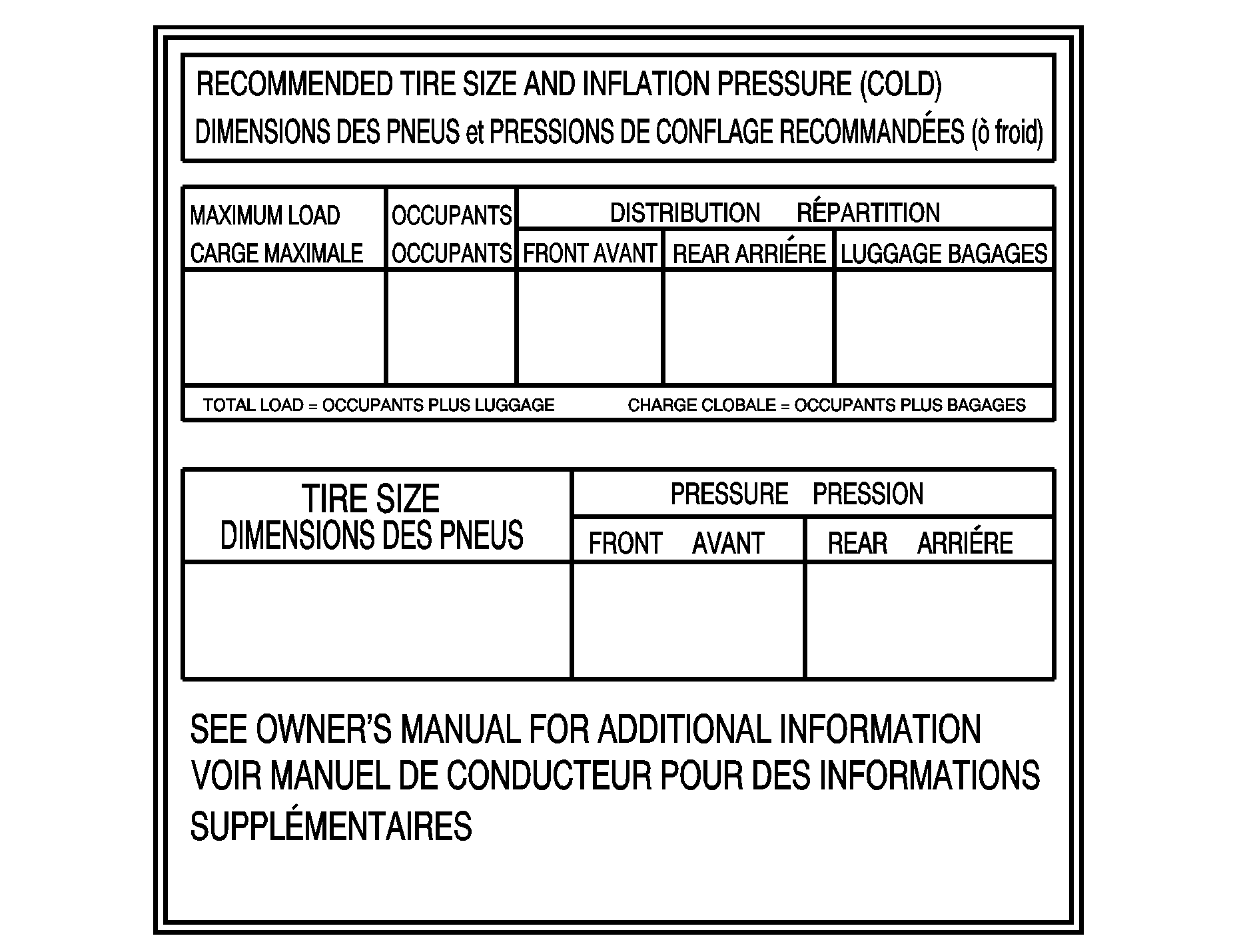
A vehicle specific tire and loading Information label is attached to the lower part of the center pillar (B-pillar) on the driver's side of the vehicle. The label shows the seating capacity and the maximum load your vehicle can properly carry. This label also shows your vehicle's original equipment tire size and the recommended tire inflation pressure. For more information on tires and inflation see Tires and Inflation - Tire Pressure .
There is also important loading information on the Certification label. It tells you the Gross Vehicle Weight Rating (GVWR) and the Gross Axle Weight Rating (GAWR) for the front and rear axle; see "Certification Label" later in this section.
Steps for Determining Correct Load Limit
- Locate the "Maximum Load" amount printed on the Tire and Loading Information label.
- Determine the combined weight of the driver and passengers that will be riding in your vehicle.
- Subtract the combined weight of the driver and passengers from the maximum load amount, shown in pounds and kilograms.
- The resulting figure equals the available amount of cargo and luggage load capacity. For example, if the "maximum load" amount equals 1400 lbs and there will be five 150 lb passengers in your vehicle, the amount of available cargo and luggage load capacity is 650 lbs (1400 - 750 (5 x 150) = 650 lbs).
- Determine the combined weight of luggage and cargo being loaded on the vehicle. That weight may not safely exceed the available cargo and luggage load capacity calculated in Step 4.
Example 1
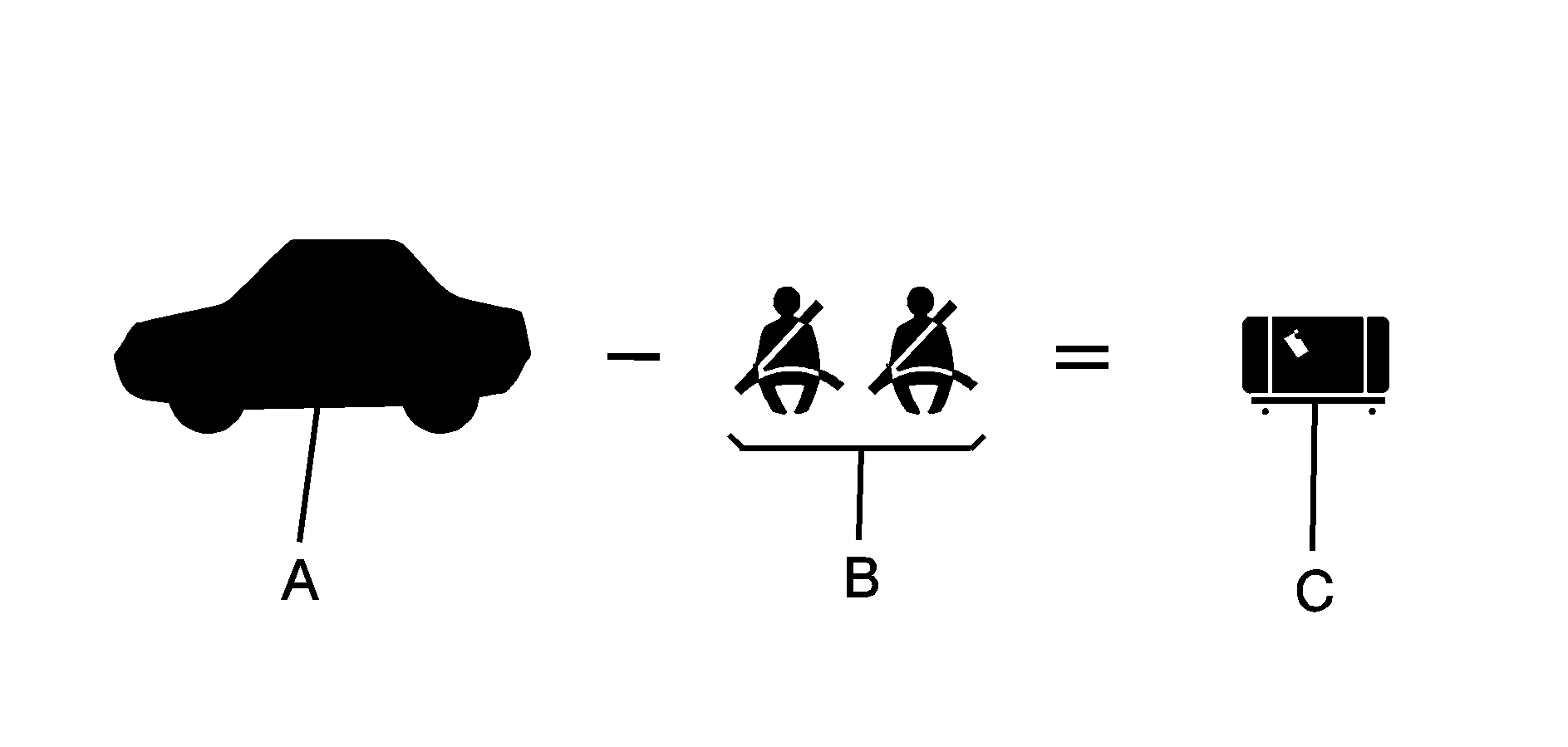
Item | Description | Total |
|---|---|---|
A | Vehicle Maximum Load for Example 1 = | 1,000 lbs (453 kg) |
B | Subtract Occupant Weight @ 150 lbs (68 kg) × 2 = | 300 lbs (136 kg) |
C | Available Occupant and Cargo Weight = | 700 lbs (317 kg) |
Example 2
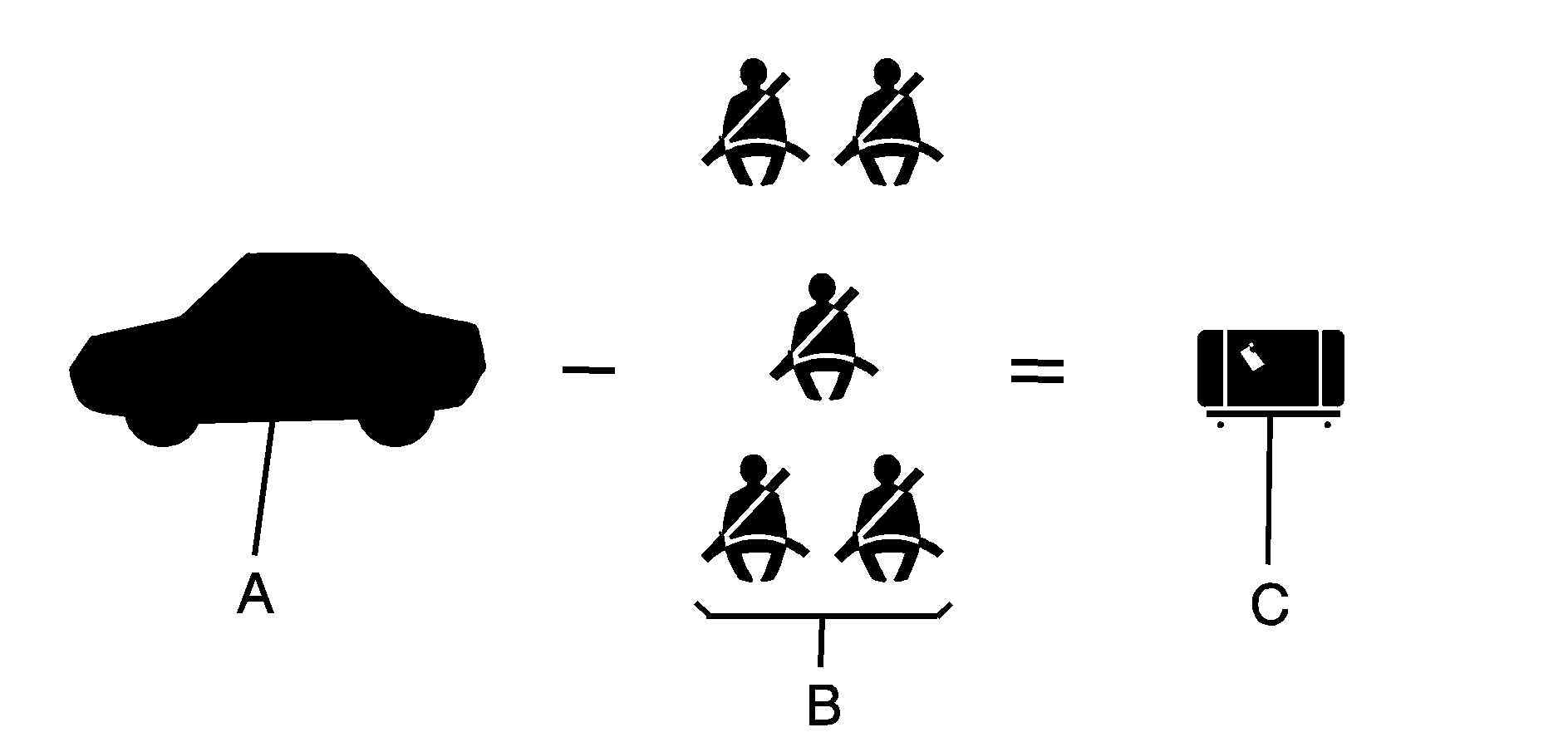
Item | Description | Total |
|---|---|---|
A | Vehicle Maximum Load for Example 2 = | 1,000 lbs (453 kg) |
B | Subtract Occupant Weight @ 150 lbs (68 kg) × 5 = | 750 lbs (340 kg) |
C | Available Cargo Weight = | 250 lbs (113 kg) |
Example 3
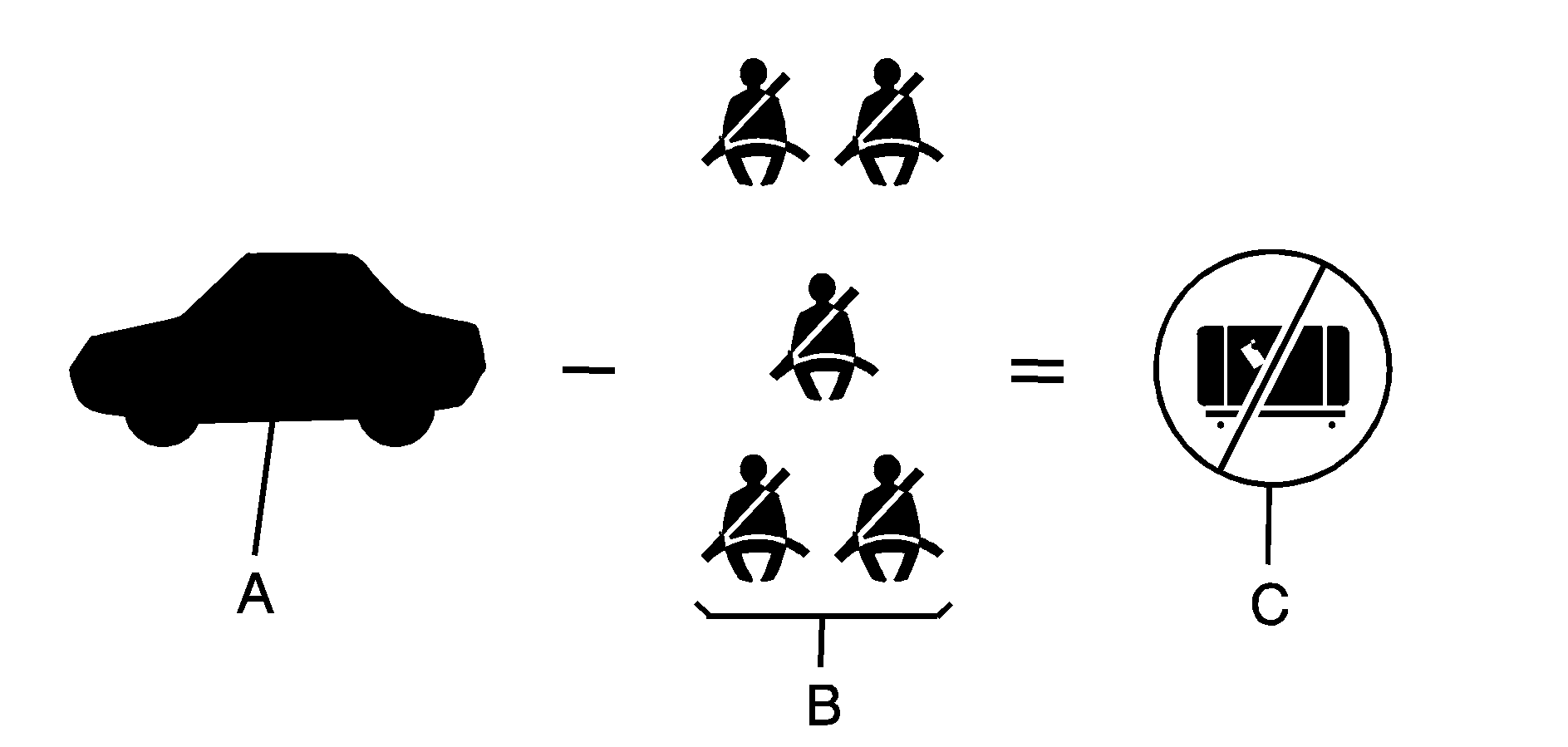
Item | Description | Total |
|---|---|---|
A | Vehicle Maximum Load for Example 3 = | 1,000 lbs (453 kg) |
B | Subtract Occupant Weight @ 200 lbs (91 kg) × 5 = | 1,000 lbs (453 kg) |
C | Available Cargo Weight = | 0 lbs (0 kg) |
Refer to your vehicle's Tire and Loading Information label for specific information about your vehicle's maximum load weight and seating positions. The combined weight of the driver, passengers, and cargo should never exceed your vehicle's maximum load weight.
Certification Label
Label Example
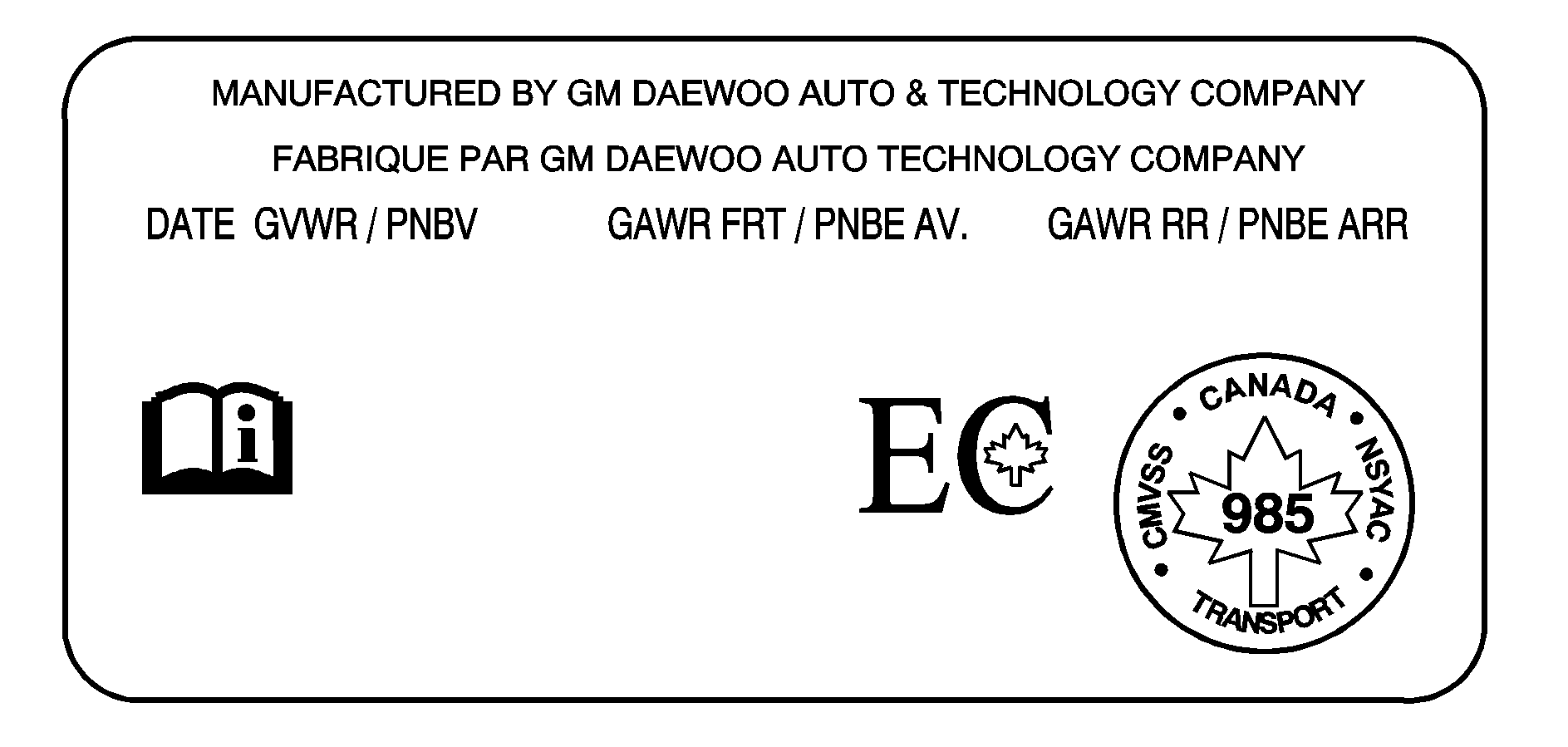
A vehicle specific Certification label is attached to the center pillar, near the driver's door latch and tells you the gross weight capacity of your vehicle, called the Gross Vehicle Weight Rating (GVWR). The GVWR includes the weight of the vehicle, all occupants, fuel, and cargo. Never exceed the GVWR for your vehicle, or the Gross Axle Weight Rating (GAWR) for either the front or rear axle.
And, if you do have a heavy load, you should spread it out. See "Steps for Determining Correct Load Limit" earlier in this section.
Caution: Do not load the vehicle any heavier than the Gross Vehicle Weight Rating (GVWR), or either the maximum front or rear Gross Axle Weight Rating (GAWR). If you do, parts on the vehicle can break, and it can change the way your vehicle handles. These could cause you to lose control and crash. Also, overloading can shorten the life of the vehicle.
Notice: Overloading your vehicle may cause damage. Repairs would not be covered by your warranty. Do not overload your vehicle.
If you put things inside your vehicle -- like suitcases, tools, packages, or anything else -- they will go as fast as the vehicle goes. If you have to stop or turn quickly, or if there is a crash, they will keep going.
Caution: Things you put inside the
vehicle can strike and injure people in a sudden stop or turn, or in a crash.
• Put things in the trunk of your vehicle. In a trunk,
put them as far forward as you can. Try to spread the weight evenly.
• Never stack heavier things, like suitcases, inside
the vehicle so that some of them are above the tops of the seats.
• Do not leave an unsecured child restraint in the vehicle.
• When you carry something inside the vehicle, secure
it whenever you can.
• Do not leave a seat folded down unless you need to.
It is very important to know how much weight your vehicle can carry. This weight is called the vehicle capacity weight or maximum load amount and includes the weight of all occupants, cargo and all nonfactory-installed options. Two labels on your vehicle show how much weight it may properly carry, the Tire and Loading Information label and the Certification label.
Caution: Do not load the vehicle any heavier than the Gross Vehicle Weight Rating (GVWR), or either the maximum front or rear Gross Axle Weight Rating (GAWR). If you do, parts on the vehicle can break, and it can change the way your vehicle handles. These could cause you to lose control and crash. Also, overloading can shorten the life of the vehicle.
Tire and Loading Information Label
Example 1 - United States
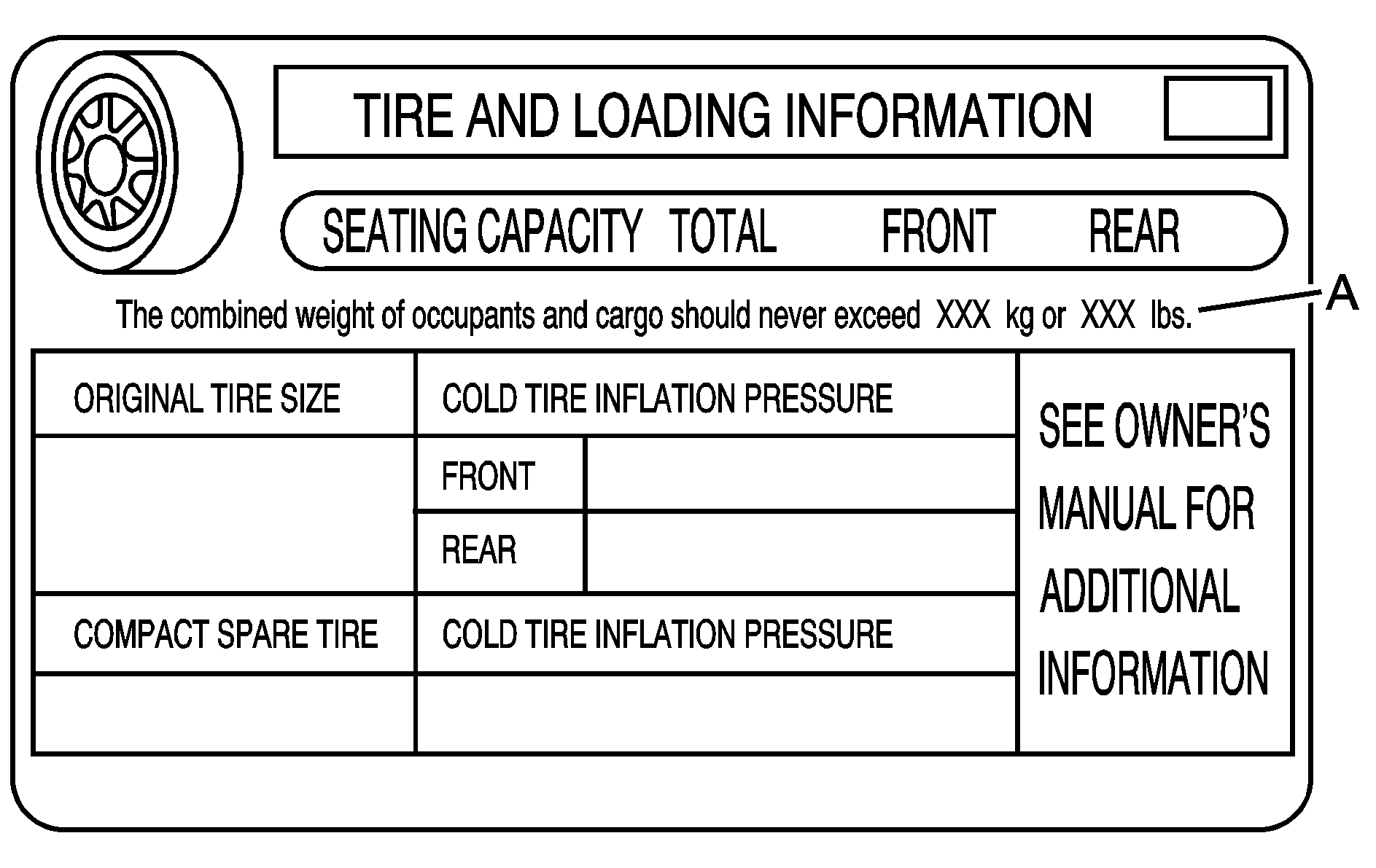
Vehicle Capacity Weight
Example 2 - Canada

The Tire and Loading Information label shows your vehicle's seating capacity, the total weight it can properly carry and the original equipment tire size and the recommended cold tire inflation pressure for those tires. For more information on tires and inflation see Tires and Inflation - Tire Pressure .
If your vehicle was purchased in the United States, the Tire and Loading Information label, Example 1, is attached to the driver's side, center pillar, below the door latch. Vehicles purchased in Canada, will find the Tire and Loading Information label, Example 2, attached to the inside of the glove compartment.
There is also important loading information on the Certification label. It tells you the Gross Vehicle Weight Rating (GVWR) and the Gross Axle Weight Rating (GAWR) for the front and rear axle; see "Certification Label" later in this section.
Steps for Determining Correct Load Limit
- If your vehicle has the Tire and Loading Information label, Example 1, locate the Vehicle Capacity Weight ". If your vehicle has the Tire and Loading Information label, Example 2, locate the "Maximum Load" amount.
- Determine the combined weight of the driver and passengers that will be riding in your vehicle.
- Subtract the combined weight of the driver and passengers from Vehicle Capacity Weight (Example 1-United States) or subtract the combined weight of the driver and passengers from Maximum Load (Example 2-Canada).
- The resulting figure equals the available amount of cargo and luggage load capacity. For example, if the Vehicle Capacity Weight or the Maximum Load amount equals 1400 lbs. (635 kg) and there will be five 150 lb. (68 kg) passengers in your vehicle, the amount of available cargo and luggage load capacity is 650 lbs. (295 kg).
- Determine the combined weight of luggage and cargo being loaded on the vehicle. That weight may not safely exceed the available cargo and luggage load capacity calculated in Step 4.
Example 1

Item | Description | Total |
|---|---|---|
A | Vehicle Capacity Weight or Maximum Load, for Example 1 = | 1,000 lbs (453 kg) |
B | Subtract Occupant Weight @ 150 lbs (68 kg) × 2 = | 300 lbs (136 kg) |
C | Available Occupant and Cargo Weight = | 700 lbs (317 kg) |
Example 2

Item | Description | Total |
|---|---|---|
A | Vehicle Capacity Weight or Maximum Load for Example 2 = | 1,000 lbs (453 kg) |
B | Subtract Occupant Weight @ 150 lbs (68 kg) × 5 = | 750 lbs (340 kg) |
C | Available Cargo Weight = | 250 lbs (113 kg) |
Example 3

Item | Description | Total |
|---|---|---|
A | Vehicle Capacity Weight or Maximum Load for Example 3 = | 1,000 lbs (453 kg) |
B | Subtract Occupant Weight @ 200 lbs (91 kg) × 5 = | 1,000 lbs (453 kg) |
C | Available Cargo Weight = | 0 lbs (0 kg) |
Refer to your vehicle's Tire and Loading Information label for specific information about your vehicle's capacity weight and seating positions. The combined weight of the driver, passengers, and cargo should never exceed your vehicle's capacity weight or maximum load weight.
Certification Label
United States
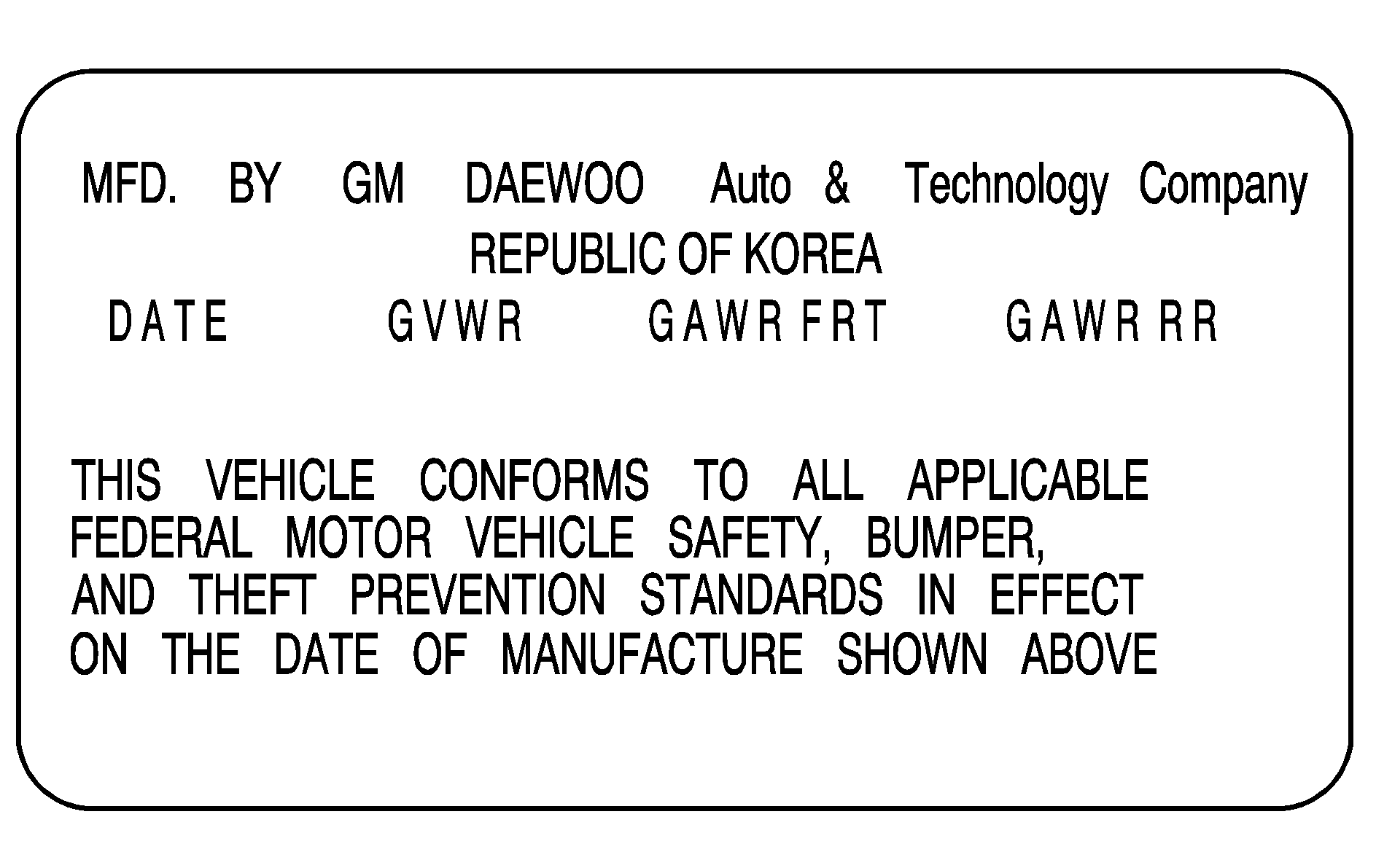
Canada
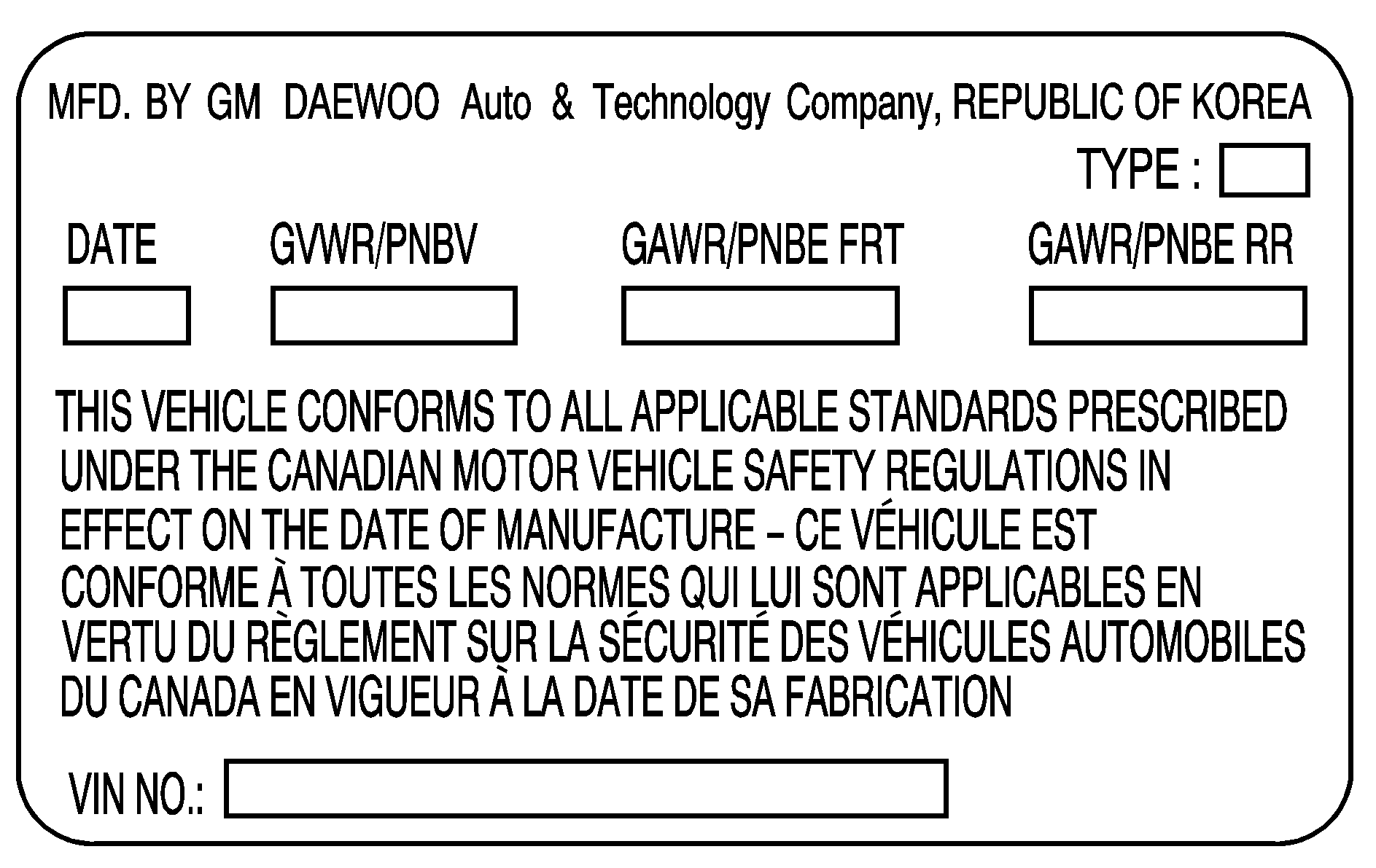
The Certification label, found either on the center pillar, near the Tire and Loading Information label or on the end of the driver's door, tells you the gross weight capacity of your vehicle, called the Gross Vehicle Weight Rating (GVWR). The GVWR includes the weight of the vehicle, all occupants, fuel and cargo. Never exceed the GVWR for your vehicle, or the Gross Axle Weight Rating (GAWR) for either the front or rear axle.
And, if you do have a heavy load, you should spread it out. Do not carry more than 110 lbs (50 kg) in your trunk.
Caution: Do not load the vehicle any heavier than the Gross Vehicle Weight Rating (GVWR), or either the maximum front or rear Gross Axle Weight Rating (GAWR). If you do, parts on the vehicle can break, and it can change the way your vehicle handles. These could cause you to lose control and crash. Also, overloading can shorten the life of the vehicle.
Notice: Overloading your vehicle may cause damage. Repairs would not be covered by your warranty. Do not overload your vehicle.
If you put things inside your vehicle -- like suitcases, tools, packages, or anything else -- they will go as fast as the vehicle goes. If you have to stop or turn quickly, or if there is a crash, they will keep going.
Caution: Things you put inside your
vehicle can strike and injure people in a sudden stop or turn, or in a crash.
• Put things in the cargo area of your vehicle. Try
to spread the weight evenly. • Never stack heavier things, like suitcases, inside
the vehicle so that some of them are above the tops of the seats. • Do not leave an unsecured child restraint in your
vehicle. • When you carry something inside the vehicle, secure
it whenever you can. • Do not leave a seat folded down unless
you need to.
It is very important to know how much weight your vehicle can carry. This weight is called the Maximum Load weight and includes the weight of all occupants, cargo and all nonfactory-installed options. Two labels on your vehicle show how much weight it may properly carry, the Tire and Loading Information label and the Certification label.
Caution: Do not load the vehicle any heavier than the Gross Vehicle Weight Rating (GVWR), or either the maximum front or rear Gross Axle Weight Rating (GAWR). If you do, parts on the vehicle can break, and it can change the way your vehicle handles. These could cause you to lose control and crash. Also, overloading can shorten the life of the vehicle.
Tire and Loading Information Label

The Tire and Loading Information label shows the seating capacity and the maximum load your vehicle can properly carry. The Tire and Loading information label is either attached to the center pillar below the door latch or inside of the glove box. This label also lists your vehicle's original equipment tire size and the recommended tire inflation pressure. For more information on tires and inflation see Tires and Inflation - Tire Pressure .
There is also important loading information on the Certification label. It tells you the Gross Vehicle Weight Rating (GVWR) and the Gross Axle Weight Rating (GAWR) for the front and rear axle; see "Certification Label" later in this section.
Steps for Determining Correct Load Limit
- Locate the "Maximum Load"amount printed on the Tire and Loading Information label.
- Determine the combined weight of the driver and passengers that will be riding in your vehicle.
- Subtract the combined weight of the driver and passengers from the maximum load amount, shown in pounds and kilograms.
- The resulting figure equals the available amount of cargo and luggage load capacity. For example, if the "maximum load" amount equals 1400 lbs. and there will be five 150 lb. passengers in your vehicle, the amount of available cargo and luggage load capacity is 650 lbs. (1400 - 750 (5 x 150) = 650 lbs).
- Determine the combined weight of luggage and cargo being loaded on the vehicle. That weight may not safely exceed the available cargo and luggage load capacity calculated in Step 4.
Example 1

Item | Description | Total |
|---|---|---|
A | Vehicle Maximum Load for Example 1 = | 1,000 lbs (453 kg) |
B | Subtract Occupant Weight @ 150 lbs (68 kg) × 2 = | 300 lbs (136 kg) |
C | Available Occupant and Cargo Weight = | 700 lbs (317 kg) |
Example 2

Item | Description | Total |
|---|---|---|
A | Vehicle Maximum Load for Example 2 = | 1,000 lbs (453 kg) |
B | Subtract Occupant Weight @ 150 lbs (68 kg) × 5 = | 750 lbs (340 kg) |
C | Available Cargo Weight = | 250 lbs (113 kg) |
Example 3

Item | Description | Total |
|---|---|---|
A | Vehicle Maximum Load for Example 3 = | 1,000 lbs (453 kg) |
B | Subtract Occupant Weight @ 200 lbs (91 kg) × 5 = | 1,000 lbs (453 kg) |
C | Available Cargo Weight = | 0 lbs (0 kg) |
Refer to your vehicle's Tire and Loading Information label for specific information about your vehicle's maximum load weight and seating positions. The combined weight of the driver, passengers, and cargo should never exceed your vehicle's maximum load weight.
Certification Label

The Certification label, found either on the center pillar, near the driver's door latch or on the end of the driver's door, tells you the gross weight capacity of your vehicle, called the Gross Vehicle Weight Rating (GVWR). The GVWR includes the weight of the vehicle, all occupants, fuel and cargo. Never exceed the GVWR for your vehicle, or the Gross Axle Weight Rating (GAWR) for either the front or rear axle.
And, if you do have a heavy load, you should spread it out. Do not carry more than 123 lbs (56 kg) in your trunk.
Caution: Do not load the vehicle any heavier than the Gross Vehicle Weight Rating (GVWR), or either the maximum front or rear Gross Axle Weight Rating (GAWR). If you do, parts on the vehicle can break, and it can change the way your vehicle handles. These could cause you to lose control and crash. Also, overloading can shorten the life of the vehicle.
Notice: Overloading your vehicle may cause damage. Repairs would not be covered by your warranty. Do not overload your vehicle.
If you put things inside your vehicle -- like suitcases, tools, packages, or anything else -- they will go as fast as the vehicle goes. If you have to stop or turn quickly, or if there is a crash, they will keep going.
Caution: Things you put inside the
vehicle can strike and injure people in a sudden stop or turn, or in a crash.
• Put things in the trunk of your vehicle. In a trunk,
put them as far forward as you can. Try to spread the weight evenly.
• Never stack heavier things, like suitcases, inside
the vehicle so that some of them are above the tops of the seats.
• Do not leave an unsecured child restraint in the vehicle.
• When you carry something inside the vehicle, secure
it whenever you can.
• Do not leave a seat folded down unless you need to.
